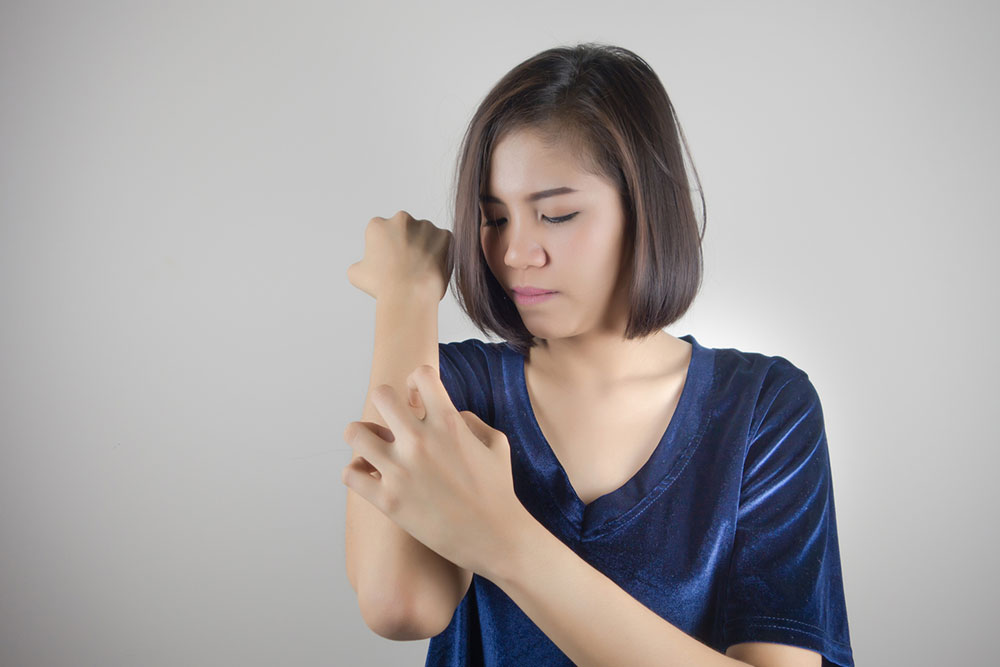9 silent signs of skin cancer

Skin cancer results in abnormal cell growth in the epidermis, the outermost layer of a person’s skin. This is primarily caused by unrepaired DNA damage that causes mutations in these cells. Like most malignancies, nearly all skin cancers can be cured if they are treated in the initial stages. For that to happen, healthcare professionals need to detect the disease based on its early, silent signs. Here are some such silent signs of skin cancer:
Red or purple lesions
Skin lesions are indicative of several things: too much body heat, skin allergies, and a host of diseases. What separates skin cancer-based lesions is that they tend to be blue, red, or purple in texture. Such lesions are actually a common early sign of a rare skin cancer called Merkel cell carcinoma. Within a few weeks of appearing, these lesions grow a few sizes visibly. Mostly, they show up in skin areas that have received a lot of sun in recent years.
Kaposi sarcoma, another kind of skin cancer, also involves the development of discolored skin and lesions. If one discovers lesions like these on their skin, they need to visit their closest healthcare professional or an oncologist immediately for a checkup.
Open sores or scabs
Another frequently encountered indicator of skin cancer is a growing number of open sores on different parts of the body. Basal cell carcinoma, a rare kind of skin cancer, manifests itself in a person’s body through sores and scabs. A majority of people with late-stage skin cancer initially dismiss these marks as instances of sunburn. This mistake can prove to be harmful in the long run, and people with a risk of skin cancer need to be extremely careful to avoid making it.
Frequent shaving nicks
Someone with skin cancer tends to frequently suffer cuts and bruises while shaving. People may mistake these injuries for clumsiness, but it is much more than that. Moreover, another initial stage of skin cancer sign is excessive and frequent bleeding. Basal cell carcinoma and squamous cell carcinoma cause bleeding after the smallest of traumas (shaving, scratching sensitive skin areas, minor cuts). If an individual suffers frequent nicks and cuts, it is best to get it checked out since this is a prevalent sign of skin malignancy developing on the epidermis. Essentially, getting shaving nicks once or twice is normal, but if the number grows beyond that, then one needs professional attention to address the problem.
Pimples that do not go away
Normally, pimples and spots appear and disappear within a matter of weeks. However, if that does not happen, then visiting a dermatologist or cancer doctor is a wise thing to do. Basal cell carcinoma and many other kinds of skin cancers show signs such as translucent, pink, or purple-colored pimples that simply do not go away within that timeframe. In fact, in some cases, the pimples may fade but then reappear in the same place. Essentially, pimples that stay for longer than three to four weeks are an early red flag for skin cancer.
Scaly patches
Normally, scaly patches are associated with other skin conditions such as eczema or, quite simply, dryness. However, these patches are a rare and often underrated sign of early-stage skin cancer. Doctors and oncology researchers have found that the early-stage emergence and spreading of malignancy on the epidermis leads to this particular issue. Apart from skin cancer, scaly patches are a common sign of health conditions like psoriasis, eczema, and seborrheic dermatitis.
Healthcare professionals can run tests to accurately diagnose these conditions and skin cancer in people. Therefore, just waiting for the patches to heal on their own or scratching them is ill-advised.
Color changes in the fingernails
A person’s fingernails can have abnormal discolorations when they develop skin cancer. So, if an individual has a dark brownish hue on their nails, that is a sign of imbalances and abnormalities developing in the skin layer beneath them. Discoloration of nails is a rare skin cancer symptom (it is associated with subungual melanoma). This kind of skin cancer is most frequently found in people who are aged 60 or older. Nevertheless, color changes are not the only irregularities one can find on the fingernails.
Formation of black or brown bands on nails
Individuals with early-stage skin cancer tend to have brown and black-tinged bands on their fingernails and toenails. While such bands may look like simple injuries or nail-polish-related mistakes, having them is a major cause for concern, even more than when the nails show an overall brown color. The thickness of these bands says a lot about the extent of the condition. Healthcare professionals tend to measure the length and width of such bands in patients to know about the extent of malignancy spread they may have.
Essentially, if the width of the band is more than two to three millimeters, then healthcare professionals advise patients to consume specific prescription-based products or begin undergoing therapy right away. A dark vertical line on the nails of a person’s fingers or toes is one of the major and frequently ignored silent signs of skin cancer.
Irregularities in the eyes
Melanoma can affect the skin areas in and around one’s eyes as well. This directly affects the functioning of one’s eyes. An individual who suffers from sudden vision difficulties is very likely to have abnormal cell growth in their eyes, a phenomenon known as ocular melanoma. Apart from that, skin cancer affects the eyes in other ways too.
Weakened immune system
All kinds of cancer weaken a person’s basic ability to fight dangerous foreign bodies such as bacteria and viruses. This is why, it is not uncommon for people with early-stage skin cancer to be frequently sick. In fact, many studies have found that people suffer infections, coughing bouts, common colds, and fevers when they have some malignancy developing within their system. Most individuals dismiss these occurrences as seasonal issues or allergies, but they can represent a much worse condition. Therefore, it is strongly recommended to get frequent illnesses checked out to diagnose any possible underlying cause for them.


